
Habich-Traut at work
Original photo by Jörn Neumann
with applied Prisma photo filter "Heisenberg". |
DREAMS OF A TREASURE
Adapted and revised from a text by Christian Parth and Jörn Neumann (Photo) (Friday, March 24, 2017)
Hobby archaeologist Erich Habich-Traut may have discovered a huge Viking shipwreck by looking at satellite images. This August the man from Solingen wants to investigate the wreck in Greenland.
Images in this article can be enlarged by clicking on them.
|
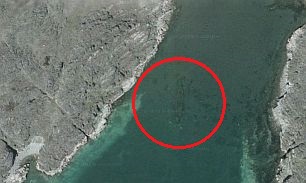
First sight of the shipwreck |
It was in the middle of an otherwise ordinary day, on the 18th of March at 2:41pm local time 2016, when Erich Habich-Traut discovered his life's dream. He sat in front of a computer in his office under the wood-clad roof of his house in Solingen-Wald, looking at Greenland in the satellite view of Google Maps.
There appeared on the edge of Disko Island a tiny outline. Habich-Traut zoomed in, rubbed his eyes and pushed his head closer towards the monitor.
"But that couldn't be ... it can not... but that's really ... ",
he thought and excitedly moved the cursor up and down the map.
|
Since then the life of the former receptionist has taken an adventurous turn.
Erich Habich-Traut may have made an archaeologically outstanding discovery with the aid of Google satellite images.
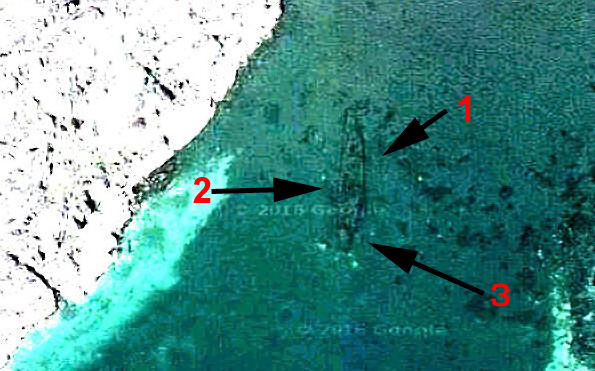 In a narrow bay, about fifty Meters off the coast of Disko Island, Greenland, in about four to six meters of depth, the wreck of a Viking longship could lie, according to his calculations.
In a narrow bay, about fifty Meters off the coast of Disko Island, Greenland, in about four to six meters of depth, the wreck of a Viking longship could lie, according to his calculations.
"It would be a World sensation," said the 53-year-old and whispered, as if no one should know yet.
He stroked his graying full beard thoughtfully and pointed to the two laptops in front of him:
"In this area so far north, there has never been a find of this kind." And it is not just any ship that he found, but an extraordinary specimen, maybe 40 meters long.
That would be news of historic dimensions, because the largest longship of the Nordic warrior race discovered so far has been the Roskilde 6, dated to the year 1025, with a length of just 36 meters.
The story of Erich Habich-Traut is the story of a man who wants to turn his life around once again, who wants to be an adventurer before fate punishes him because he simply did nothing, was too cowardly to follow a feeling which has been slumbering in him for 30 years.
There is no doubt,
there is a wreck
Erich Habich-Traut |
Habich-Traut sits at a glas table in the dining room of his house in Solingen-Wald, a better area of town, as he emphasizes.
Habich-Traut, born in the Keupstraße in Cologne, wears jeans held by a belt buckle shaped liked a Viking sun disc, from his neck dangles a small stainless steel boomerang. |
The visitor immediately realizes that he is the guest of a researcher. Outside in the garden, two hybrid chickens peck in the grass, each delivering an egg every day:
"Highly efficient animals. But not very durable. It may be that after one and a half years they simply fall over dead from exhaustion," he says, as if it were a reminder of his own finitude.
His eyes wander through the room. On a sideboard stands a model of the Millennium Falcon from "Star Wars", in a glass showcase is a model of the lunar lander from Apollo 11.
"My wife's father Walter Traut didn't just built that scale model. He was systems integrator for the Apollo program at Grumman aerospace, in charge of assembling the real lunar module."
The Japanese toilet in the bathroom has so many knobs that one is afraid that a wrong button press could launch the white ceramic and its user off on a Mars trajectory.
Habich-Traut hardly dares to tell why he came to look for something extraordinary on Google Maps.
His own story appears himself to be too cheesy, maybe too unbelievable:
Thirty years ago, Habich-Traut had a dream.
He dreamed of being in some kind of vessel with a crew and saw from a height an ice covered island below. The vessel was about to crash. Somehow he perceived or overheard a set of numbers that he knew were very important before the dream ended.
When he awoke the next morning, the numbers were still in his head and he wrote them down. Once down on paper, it occurred to him that the numbers looked like geographical coordinates.
The following Monday he went to a public library and borrowed an atlas to check the data.
His finger landed near Disko Island, located in a marginal sea off the Atlantic Ocean. Today about 1100 mostly Inuit inhabitants live on the island, which was first settled by the Thule civilization in 1500 CE.
"Since then, I've always wondered what it was about this dream."
He never forgot the island because of its unusual name, Disko Island.
But first of all the learned printer travelled through the world, working in Israel, Belgium, England and Ireland, which is why he is still rolling the "R" today, and many of his sentences are starting with "Well".
Then, however, whilst living in London, the second Iraq war started in 2003 and he left the UK in protest.
From this time he still has a "Thank You" letter for his efforts to stop the Iraq war from MP Alex Salmond, the then leader of the Scottish National Party until 2014.
Upon returning to Germany he took a job as a receptionist for lack of a better offer.
He is reluctant to talk about this time, "because it was a dead end job. A waste of lifetime", he says softly. It took him 13 years to realize this. Last year, Habich-Traut quit his job.
He had remembered those coordinates and the island.
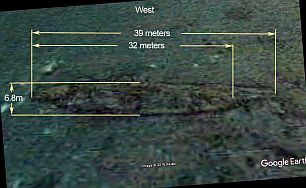 The fact that he finally discovered a shadowy outline through Google Maps now appears to him as fate. He excludes a mapping error of Google.
The fact that he finally discovered a shadowy outline through Google Maps now appears to him as fate. He excludes a mapping error of Google.
"There's no doubt there's a wreck," he says, straightening his hair. On the second of April 2016 he posted the picture of the shipwreck on Facebook.
His friends responded politely: "Eric, that sounds quite interesting." He dug into the blueprints of Viking ships, studied ship registers, which list sunken ships from the 16th century onward and immersed himself in the history of his namesake "Eric the Viking" who was banished from Norway in the year 985 CE.
In his search for the best place for a new home, he speculates,
Eric the Red sailed the West coast of Greenland up to the North, up into into the Arctic Circle.
During this time, according to Habich-Traut, the Vikings discovered Disko Island and left some record of this in a lost saga, which found its reflection in Olaus Magnus "Carta Marina" map from 1539, where an Island was drawn called "Thule".
It was the Greek explorer Pytheas who first described Thule in 320 BCE as an Island in the Atlantic where the Sun doesn't set.
Disko Island is also a land where the sun doesn't set in the summer, because it is so far North that it is in the Arctic Circle.
In around 40 AD the Roman philosopher Seneca wrote:
"There will come an age in the far-off years when Ocean shall unloose the bonds of things, when the whole broad earth shall be revealed, when Tethys shall disclose new worlds and Thule not be the limit of the lands."
----------------------------------
Habich-Traut sent the satellite image to several scientists to get an informed opinion. But the experts did not respond in writing.
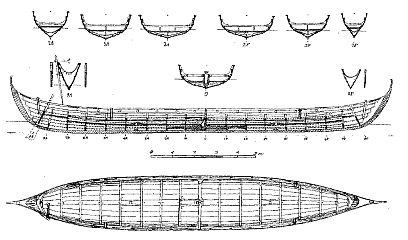
Norse longship drawing |
First he turned to the Archaeological Institute of the University of Cologne, which in turn referred him to the German Society for the Promotion of Underwater Archaeology. They said he should try the German Maritime Museum. No answer.
Habich-Traut was frustrated. Was his discovery perhaps just a dead duck?
Dissatisfied with the lack of response from the German scientific community he got in touch with Danish and Greenlandic universities and archaeologists.
|
"It wasn't that I asked if they could confirm that this was a Viking longboat, I simply asked what they thought it might be, even if they could agree with me that it was a simple shipwreck. But scientists don't act like an oracle. If they don't know about something with certainty, they don't speculate about it to strangers."
 The only response Habich-Traut got was about a longhouse he also discovered on Disko Island. The deputy director of the National Museum of Greenland, Bo Albrechtsen, confirmed its existence, saying that it most likely belonged to the Thule civilization. The Thule civilization being Eskimo/Inuit in origin.
The only response Habich-Traut got was about a longhouse he also discovered on Disko Island. The deputy director of the National Museum of Greenland, Bo Albrechtsen, confirmed its existence, saying that it most likely belonged to the Thule civilization. The Thule civilization being Eskimo/Inuit in origin.
"But no-one has investigated this longhouse further, even though it could be Viking or Norse. No archaeological excavation was done there, because even though the Vikings also built longhouses, the consensus is that they didn't settle so far North. Therefore it cannot be of Viking origin? "
The longhouse is 11 km west of the shipwreck location.
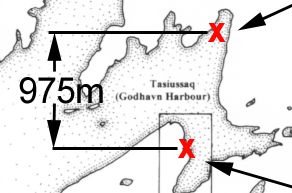 Finally, in January 2017, he discovered that there had been an expedition to a different shipwreck within a 1000 yards of "his" shipwreck at Disko Island in 2003, led by James Delgado.
Finally, in January 2017, he discovered that there had been an expedition to a different shipwreck within a 1000 yards of "his" shipwreck at Disko Island in 2003, led by James Delgado.
"James is not just anyone," says Habich-Traut proudly. "He's one of the World's foremost underwater archaeologists and has surveyed over 100 wrecks". One of those wrecks was the Titanic, as scientific leader under director James Cameron with the National Geographic.
On 27th January this year, Delgado replied to a request by Habich-Traut. A few words of encouragement made Habich-Traut happy.
A satellite image of Google Maps and a response from the famous James Delgado - that had to be enough.
Habich-Traut is convinced that nothing will stop him from his mission. On the 14th of August 2017 it is to start.
Driving with the Model S to Copenhagen, taking advantage of the Tesla Supercharger Network, from there by plane to Kangerlussuaq, then a propeller machine to Aasiaat on the west coast of Greenland, then by ferry to Disko Island, aka Qeqertarsuaq (Big Island) in the Inuit language.
He will be accompanied by his wife Carol and possibly a two man team from the German "GEO" magazine.
"We have a verbal agreement that the GEO team will travel with us to cover the expedition.", says Habich-Traut.
He published a 16-page documentation on the Internet in February in hopes that it will explain the background and possible scope of the discovery and attract crowdfunding sponsors. He has calculated a cost of about 4000 Dollars per person for the one-week expedition.
He hopes to be spending the week in the Arctic research station of the Danes, which is located on the edge of the township of Godhavn. He has already established the contact. He would have access to the facilities and possible field assistance, including the hire of a dinghy boat, if required.
On Ebay he bought a used dry dive suit for 250 Euro, which has since been exhibited like a museum piece in his man cave. On top of the suit - a joke he has prepared for visiting reporters - he arranged a Viking helmet from a shop for carnival accessories.
 For most of the year the shipwreck is covered by ice
For most of the year the shipwreck is covered by ice |
Soon, in the Arctic summer, he wants to plunge into the then two-degree cold waters of the Arctic sea with the suit and a snorkel. Because there are no facilities to fill air bottles in the Arctic. Diving is not in high demand in a region where the sea is frozen for most of the year.
Habich-Traut learned diving and received his open water diver brevet in May, despite of that. "Just in case", he says. For a couple of weeks he attended a diving course with PADI diving school "Underwater No. 1" in Düsseldorf.
|
When he collected his certificate a local TV station accompanied him to film the event, which will be broadcast at the end of May across North Rhine-Westphalia, Germany's largest county.
"I am very happy that this story is beginning to gain traction", Habich-Traut beams. It took a long time from his first posts on Facebook, to running adverts in newspapers to find a TV crew, to reports in the local and then regional press and then the first TV coverage and finding his first sponsor, Underwater Kinetics from California.
For the hobby-researcher from Solingen a race against time has begun. Too many scientists are now aware of his discovery, he believes.
Who can tell if someone is not already on his way to Disko Island to dispute his glory?
A reporter wrote that Habich-Traut dreams of the day when he will have discovered a Viking ship. The day when distinguished historians and archaeologists pat him on the shoulder.
And that even if he returns home empty-handed, friends would say to him, "You have pulled it through."
---------------------------------------
I am always torn between explaining just the current step or also to attempt to explain the underlying theory.
This article is an example of that.
Nevertheless, for the sake of completeness, and even though the details are patchy, the following items give a clue to my train of thought:
In 1999 I wrote about an experiment I attended: "Faster Than Light Transmission Of Signals In A Double Prism" with Prof. Dr. Nimtz, Dept. of Theoretical Physics at Cologne University.
The Nimtz effect deals with quantum tunneling (respectively entanglement) describing the transfer of information across time.
I have an inkling of how this is possible:
The information may manifest in a sleep phase,
perchance to dream.
In this context it makes not much difference if there will be a Viking or a whaling boat.
To me, only observations can untangle facts.
That is the real treasure.







